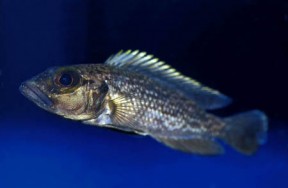Lamprologus lemairii
Lemaire's Lamprologus
Classification
Cichlidae
Distribution
Endemic to Lake Tanganyika.
Habitat
This species has no specific habitat, although it is most often seen around the shorelines of the lake.
Maximum Standard Length
10″ (25cm)
Aquarium SizeTop ↑
48″ x 18″ x 15″ (120cm x 45cm x 37.5cm) – 200 litres
Maintenance
L. lemairii has no special requirements with regards to decor. A sandy substrate is preferable, and the tank can be decorated with piles of rocks as with general Tanganyikan setups.
Water Conditions
Temperature: 73-81°F (23-27°C)
pH: 7.5-9.0
Hardness: 10-25°H
Diet
It is an exclusive piscivore in nature but there is no need to feed live fish in aquaria, as it accepts dead foods readily. Feed a meaty diet of prawns, lancefish, whitebait etc. Do not feed animal meat of any kind.
Behaviour and CompatibilityTop ↑
Should only be kept with robust species too large to be considered food. Suitable tankmates include Frontosa, Benthochromis tricoti and other large Rift Lake species. It is a loner in nature and therefore should be kept as a solitary specimen in the aquarium.
Sexual Dimorphism
Cannot be sexed by external means.
Reproduction
It has not been bred in captivity but is known to spawn in caves in nature.
NotesTop ↑
A highly piscivorous, predatory species unsuited to the general aquarium. It is an ambush predator in nature, often being seen hanging motionless around rocky structures or on the floor of the lake. It is a sedentary species and does not move around a lot. This is a behavioural adaptation known as thanatosis, or ‘playing dead’. This strategy is usually used as a defensive means in other animals, but in L. lemairii it is adapted for offensive means. The fish has a mottled colour pattern and this, combined with the aforementioned ability to lie motionless on the substrate, makes the fish appear dead to unsuspecting prey. When a smaller fish attempts to investigate the ‘corpse’ it recieves a nasty surprise! We do not recommend this fish for the home aquarium, except to true enthusiasts.



